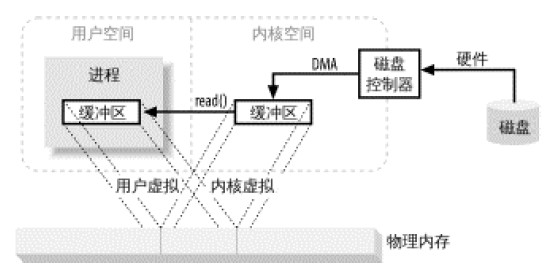1. 在JAVA传统的IO系统中,读取磁盘文件数据的过程如下:
以FileInputStream类为例,该类有一个read(byte b[])方法,byte b[]是我们要存储读取到用户空间的缓冲区。参看read(byte b[])方法的源码,可知,它会在内部再调用readBytes(b, 0, b.length)方法,而且readBytes(b, 0, b.length)方法是一个native方法(即本地方法),最终通过这个本地方法来发起一次系统调用,即调用系统内核的read()方法,内核从磁盘读取数据到内核缓冲区,这个过程由磁盘控制器通过DMA操作将数据从磁盘读取内核缓冲区,此过程不依赖于CPU。然后用户进程再将数据从内核缓冲区拷贝到用户空间缓冲区。用户进程再从用户空间缓冲区中读取数据。因为用户进程是不可以直接访问硬件的。所以需要通过内核来充当中间人的作用来实现文件的读取。
整个过程如下图所示:
2. 自从JAVA 1.4以后,JAVA在NIO在引入了文件通道的概念,和传统IO最大的区别是:传统IO是基于Byte(字节)和Stream(流)的,而NIO是基于Buffer(缓冲)、Channel(通道)在API中有提供了一个FileChannel类和Selector(选择器)的,该类与传统的IO流进行关联。可以由FileInputStream或FileOutputStream获取该文件通道,我们可以通过通道对文件进行读写操作。
3.JAVA NIO中还引入了文件内存映射的概念:现代操作系统大都支持虚拟内存映射,这样,我们可以把内核空间地址与用户空间的虚拟地址映射到同一个物理地址,这样,DMA 硬件(只能访问物理内存地址)就可以填充对内核与用户空间进程同时可见的缓冲区了。如下图所示:

下面就看下使用IO,BufferedIO和NIO分别实现的文件复制耗时比较:11兆音频文件
传统IO方法实现文件拷贝耗时:21ms
利用NIO文件通道方法实现文件拷贝耗时:16ms
利用NIO文件内存映射及文件通道实现文件拷贝耗时:7ms
利用FileUtils文件拷贝工具类耗时:53ms
package com.maystar.utils;
import java.io.File;
import java.io.FileInputStream;
import java.io.FileOutputStream;
import java.nio.MappedByteBuffer;
import java.nio.channels.FileChannel;
import org.apache.commons.io.FileUtils;
public class FileCopyTest {
public static void main(String[] args) throws Exception {
String sourcePath = "F:\\glzmv.mp3";
String destPath1 = "F:\\glzmvCopy1.mp3";
String destPath2 = "F:\\glzmvCopy2.mp3";
String destPath3 = "F:\\glzmvCopy3.mp3";
String destPath4 = "F:\\glzmvCopy4.mp3";
long t1 = System.currentTimeMillis();
traditionalCopy(sourcePath,destPath1);
long t2 = System.currentTimeMillis();
System.out.println("传统IO方法实现文件拷贝耗时:" + (t2-t1) + "ms");
nioCopy(sourcePath,destPath2);
long t3 = System.currentTimeMillis();
System.out.println("利用NIO文件通道方法实现文件拷贝耗时:" + (t3-t2) + "ms");
nioCopy2(sourcePath,destPath3);
long t4 = System.currentTimeMillis();
System.out.println("利用NIO文件内存映射及文件通道实现文件拷贝耗时:" + (t4-t3) + "ms");
nioCopy3(sourcePath,destPath4);
long t5 = System.currentTimeMillis();
System.out.println("利用FileUtils文件拷贝耗时:" + (t5-t4) + "ms");
}
private static void nioCopy3(String sourcePath, String destPath) throws Exception {
File source = new File(sourcePath);
File dest = new File(destPath);
FileUtils.copyFile(source, dest);//查看源码commons-io-2.4也使用的是nio操作,实现类似nioCopy操作,但是为什么效率比nioCopy要低,原因是在FileUtils.copyFile执行doCopyFile完成调用IOUtils工具类关闭流操作,根据不同类型的流调用对应的构造方法。
}
private static void nioCopy2(String sourcePath, String destPath) throws Exception {
File source = new File(sourcePath);
File dest = new File(destPath);
if(!dest.exists()) {
dest.createNewFile();
}
FileInputStream fis = new FileInputStream(source);
FileOutputStream fos = new FileOutputStream(dest);
FileChannel sourceCh = fis.getChannel();
FileChannel destCh = fos.getChannel();
MappedByteBuffer mbb = sourceCh.map(FileChannel.MapMode.READ_ONLY, 0, sourceCh.size());
destCh.write(mbb);
sourceCh.close();
destCh.close();
}
private static void traditionalCopy(String sourcePath, String destPath) throws Exception{
File source = new File(sourcePath);
File dest = new File(destPath);
if(!dest.exists()) {
dest.createNewFile();
}
FileInputStream fis = new FileInputStream(source);
FileOutputStream fos = new FileOutputStream(dest);
byte [] buf = new byte [fis.available()];
int len = 0;
while((len = fis.read(buf)) != -1) {
fos.write(buf, 0, len);
}
fis.close();
fos.close();
}
private static void nioCopy(String sourcePath, String destPath) throws Exception{
File source = new File(sourcePath);
File dest = new File(destPath);
if(!dest.exists()) {
dest.createNewFile();
}
FileInputStream fis = new FileInputStream(source);
FileOutputStream fos = new FileOutputStream(dest);
FileChannel sourceCh = fis.getChannel();
FileChannel destCh = fos.getChannel();
destCh.transferFrom(sourceCh, 0, sourceCh.size());
sourceCh.close();
destCh.close();
}
}
 带你搞懂Java结构化数据处理开源库SPLMay 24, 2022 pm 01:34 PM
带你搞懂Java结构化数据处理开源库SPLMay 24, 2022 pm 01:34 PM本篇文章给大家带来了关于java的相关知识,其中主要介绍了关于结构化数据处理开源库SPL的相关问题,下面就一起来看一下java下理想的结构化数据处理类库,希望对大家有帮助。
 Java集合框架之PriorityQueue优先级队列Jun 09, 2022 am 11:47 AM
Java集合框架之PriorityQueue优先级队列Jun 09, 2022 am 11:47 AM本篇文章给大家带来了关于java的相关知识,其中主要介绍了关于PriorityQueue优先级队列的相关知识,Java集合框架中提供了PriorityQueue和PriorityBlockingQueue两种类型的优先级队列,PriorityQueue是线程不安全的,PriorityBlockingQueue是线程安全的,下面一起来看一下,希望对大家有帮助。
 完全掌握Java锁(图文解析)Jun 14, 2022 am 11:47 AM
完全掌握Java锁(图文解析)Jun 14, 2022 am 11:47 AM本篇文章给大家带来了关于java的相关知识,其中主要介绍了关于java锁的相关问题,包括了独占锁、悲观锁、乐观锁、共享锁等等内容,下面一起来看一下,希望对大家有帮助。
 一起聊聊Java多线程之线程安全问题Apr 21, 2022 pm 06:17 PM
一起聊聊Java多线程之线程安全问题Apr 21, 2022 pm 06:17 PM本篇文章给大家带来了关于java的相关知识,其中主要介绍了关于多线程的相关问题,包括了线程安装、线程加锁与线程不安全的原因、线程安全的标准类等等内容,希望对大家有帮助。
 Java基础归纳之枚举May 26, 2022 am 11:50 AM
Java基础归纳之枚举May 26, 2022 am 11:50 AM本篇文章给大家带来了关于java的相关知识,其中主要介绍了关于枚举的相关问题,包括了枚举的基本操作、集合类对枚举的支持等等内容,下面一起来看一下,希望对大家有帮助。
 详细解析Java的this和super关键字Apr 30, 2022 am 09:00 AM
详细解析Java的this和super关键字Apr 30, 2022 am 09:00 AM本篇文章给大家带来了关于Java的相关知识,其中主要介绍了关于关键字中this和super的相关问题,以及他们的一些区别,下面一起来看一下,希望对大家有帮助。
 Java数据结构之AVL树详解Jun 01, 2022 am 11:39 AM
Java数据结构之AVL树详解Jun 01, 2022 am 11:39 AM本篇文章给大家带来了关于java的相关知识,其中主要介绍了关于平衡二叉树(AVL树)的相关知识,AVL树本质上是带了平衡功能的二叉查找树,下面一起来看一下,希望对大家有帮助。
 一文掌握Java8新特性Stream流的概念和使用Jun 23, 2022 pm 12:03 PM
一文掌握Java8新特性Stream流的概念和使用Jun 23, 2022 pm 12:03 PM本篇文章给大家带来了关于Java的相关知识,其中主要整理了Stream流的概念和使用的相关问题,包括了Stream流的概念、Stream流的获取、Stream流的常用方法等等内容,下面一起来看一下,希望对大家有帮助。


热AI工具

Undresser.AI Undress
人工智能驱动的应用程序,用于创建逼真的裸体照片

AI Clothes Remover
用于从照片中去除衣服的在线人工智能工具。

Undress AI Tool
免费脱衣服图片

Clothoff.io
AI脱衣机

AI Hentai Generator
免费生成ai无尽的。

热门文章

热工具

MinGW - 适用于 Windows 的极简 GNU
这个项目正在迁移到osdn.net/projects/mingw的过程中,你可以继续在那里关注我们。MinGW:GNU编译器集合(GCC)的本地Windows移植版本,可自由分发的导入库和用于构建本地Windows应用程序的头文件;包括对MSVC运行时的扩展,以支持C99功能。MinGW的所有软件都可以在64位Windows平台上运行。

SublimeText3 英文版
推荐:为Win版本,支持代码提示!

EditPlus 中文破解版
体积小,语法高亮,不支持代码提示功能

VSCode Windows 64位 下载
微软推出的免费、功能强大的一款IDE编辑器

ZendStudio 13.5.1 Mac
功能强大的PHP集成开发环境





